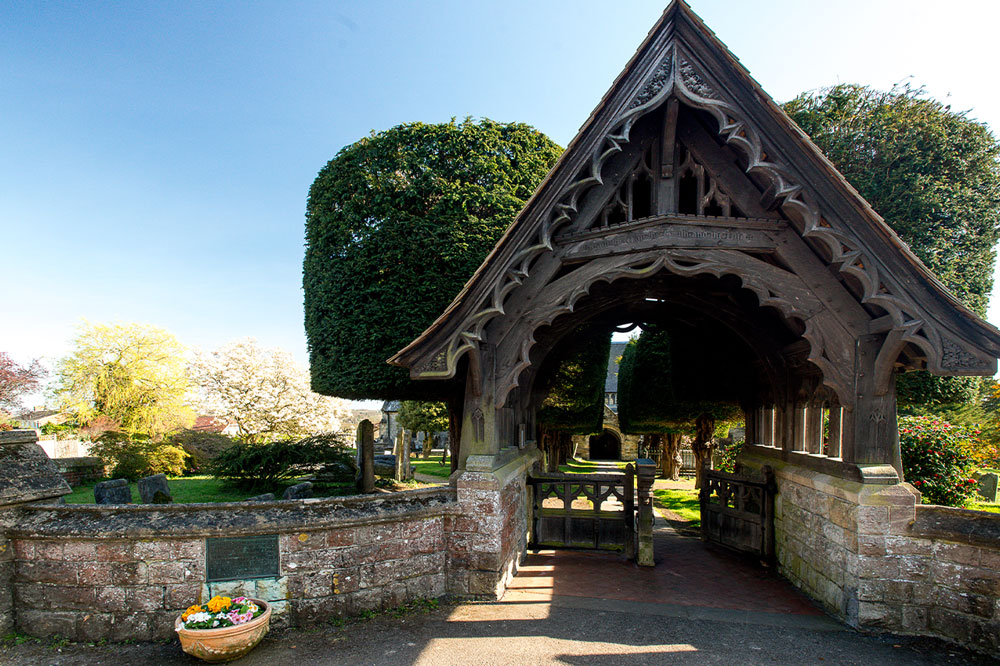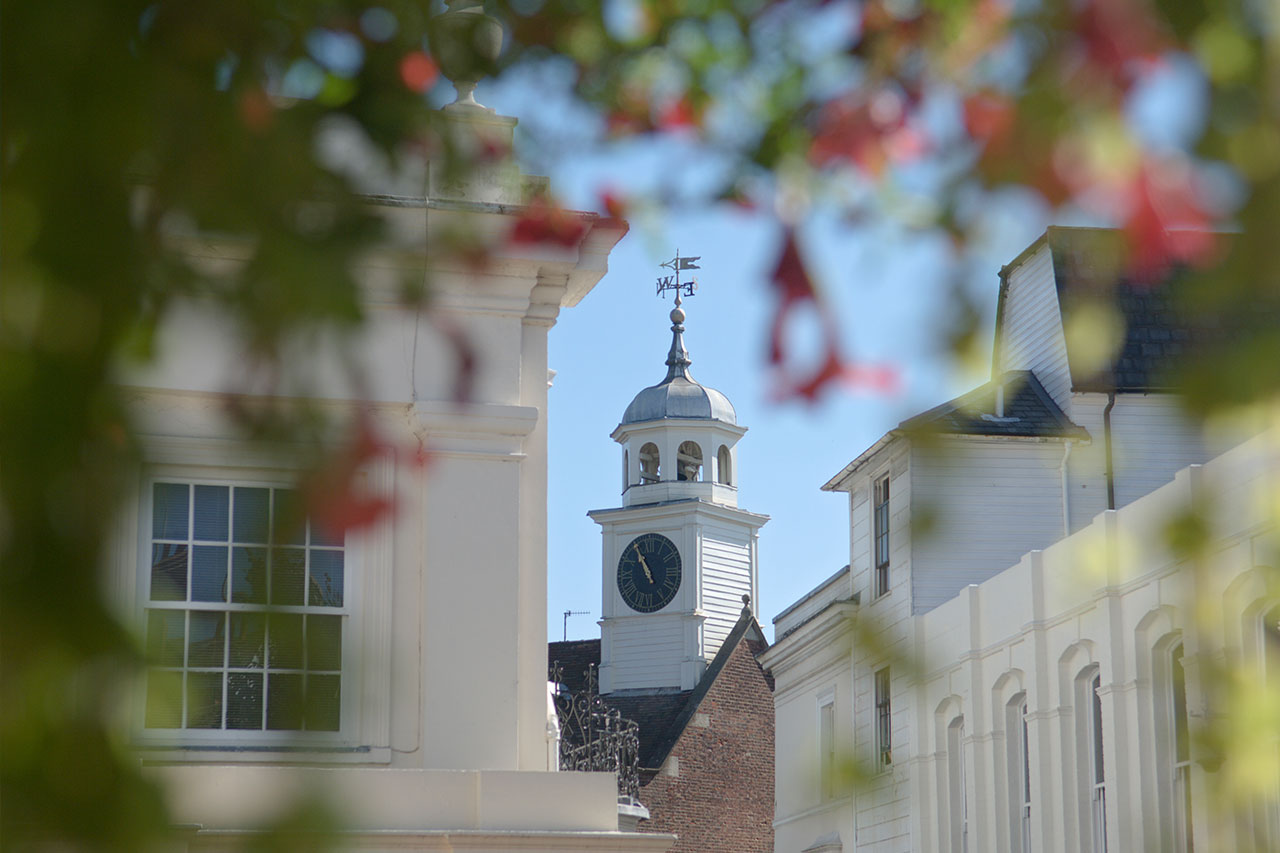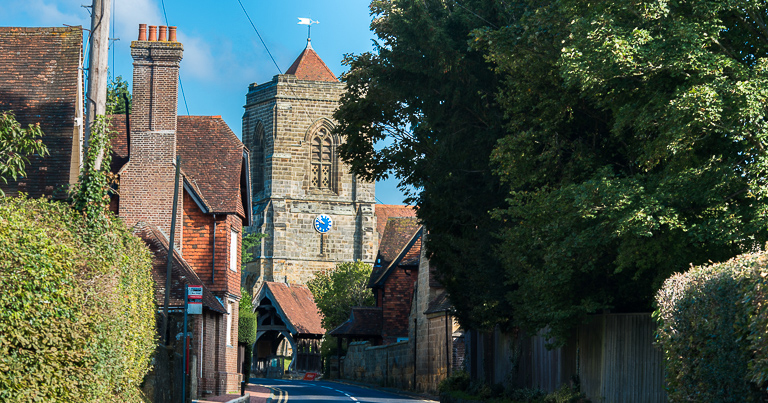There are 13 significant churches of historical interest around the borough of Tunbridge Wells. All are located in stunning spots amongst the picturesque Wealden countryside too. Entrancing stories are an integral part of each and every church. Find a moustachioed angel in one, a pirate in another and a handful in the Doomsday book!
Must-see churches around Tunbridge Wells.

All Saints Church, Tudeley
All Saints Church in Tudeley, Kent, holds a unique and remarkable distinction as the only church in the world adorned with stained glass windows designed by the renowned Russian-French artist Marc Chagall. The church itself is an exquisite medieval structure, dating back to the 12th century, with a tranquil setting in the picturesque countryside. However, what truly sets All Saints Church apart is the breath-taking collection of Chagall’s stained glass masterpieces, commissioned in the 1960s by Sir Henry and Lady d’Avigdor-Goldsmid as a tribute to their daughter, Sarah. These stunning windows depict biblical scenes and themes, displaying Chagall’s signature use of vibrant colors and dreamlike imagery. The interplay between the historic architecture and Chagall’s modern artistic vision creates a captivating and spiritually enriching experience for visitors, making All Saints Church in Tudeley a truly extraordinary destination for art and history enthusiasts alike.
All Saints Church, Brenchley
All Saints’ Church in Brenchley has unique exhibitions of artistic glory by Bell and the company Morris & Co in its stained glass windows too. It is a picturesque and historic Anglican church nestled in the heart of the charming village of Brenchley. Steeped in history, the church’s origins can be traced back to the 12th century, with subsequent additions and renovations over the centuries contributing to its unique architectural character. The church features a stunning medieval tower, adorned with intricate stonework, and its interior boasts beautiful stained glass windows, a testament to the craftsmanship of bygone eras. The serene churchyard provides a peaceful resting place for centuries of local residents, and the church itself remains an active center for worship, community events, and cultural activities.


St Mary’s, Goudhurst
Perched proudly atop a steep and winding hill, St Mary’s Church in Goudhurst is a magnificent landmark that commands breath-taking views of the surrounding countryside. The church’s squat tower, a distinctive feature on the skyline, beckons visitors to ascend its heights on summer weekends. The reward for this ascent is nothing short of spectacular—a panorama that stretches approximately 23 miles to the south coast of Kent on clear days. St Mary’s itself is a testament to the architectural and historical richness of the area, with its roots dating back through the centuries. It bears witness to the tumultuous events of the past, including the infamous Hawkhurst Smugglers’ Battle.
Beyond its religious significance, the church serves as a vantage point, inviting both locals and visitors to appreciate the scenic beauty that graces the picturesque village of Goudhurst and the idyllic landscapes that unfold beneath its lofty perch.
King Charles the Martyr, Royal Tunbridge Wells
King Charles the Martyr holds a special place in the history of Royal Tunbridge Wells, symbolizing the town’s emergence as a respectable and sought-after spa destination in the seventeenth century. The church, dedicated to the memory of King Charles I, became a focal point for the community, reflecting the era’s religious and political dynamics. The town’s genteel reputation owes much to the presence of this historic landmark, which played a significant role in shaping the character of Royal Tunbridge Wells. Interestingly, the church also has a connection to the beloved literary character Winnie the Pooh, as it is said to be a place where the fictional bear liked to sit. For those eager to delve deeper into this intriguing history, guided tours offer a fascinating exploration of the town’s past and the unique stories associated with King Charles the Martyr.


St Thomas a Becket Church, Capel
A small Norman Wealden church nestled in the picturesque village of Capel. Dating back to the 13th century, the church is adorned with significant wall paintings from that era, offering a captivating glimpse into medieval artistry and religious expression. The structure itself showcases a harmonious blend of architectural styles, including noteworthy 14th-century features. The church’s tower, a prominent aspect of its silhouette, underwent partial reconstruction in 1639 following a fire, adding another layer to its rich history. The enduring beauty of St. Thomas a Becket Church lies not only in its ancient stones but also in its role as a spiritual anchor for the community, hosting worship services and cultural events that connect the present with the profound heritage of Capel.
St Dunstan Church, Cranbrook
St. Dunstan’s is an unusually large church, often referred to as ‘the Cathedral of the Weald,’ a moniker that aptly captures its impressive size and grandeur. The church’s expansive dimensions are attributed to the prosperity of the region between 1300 and 1500, driven by a thriving cloth industry. The wealth generated during this period allowed for the construction of a church that not only served as a place of worship but also stood as a symbol of the economic success of Cranbrook. One of the notable features of St. Dunstan’s is its distinctive clock tower, which holds historical significance as a prototype for the bells of Big Ben. This connection to one of London’s iconic landmarks adds an extra layer of intrigue to the church’s legacy, making it a destination for history enthusiasts and architecture aficionados alike.


St Mary’s Church, Lamberhurst
Dating back to the 13th century, this Anglican church exudes an air of timeless elegance and architectural grace. The church is characterized by its impressive medieval tower and a nave that boasts a combination of Norman and Gothic features. St. Mary’s is adorned with beautiful stained-glass windows, showcasing intricate craftsmanship and depicting scenes from religious narratives. The churchyard surrounding St. Mary’s provides a tranquil setting, offering a peaceful final resting place for generations of locals. Beyond its religious significance, St. Mary’s Church serves as a focal point for community gatherings, cultural events, and musical performances.
St Mary’s Church, Speldhurst
A charming and historic parish church located in the picturesque village of Speldhurst, near Royal Tunbridge Wells. With roots dating back to the medieval period, St. Mary’s is an architectural gem that has witnessed centuries of worship and community life. The church’s notable features include a distinctive spire that graces the village skyline, a beautiful nave with elegant arches, and a collection of exquisite stained-glass windows that depict religious scenes and local history. The churchyard, adorned with ancient tombstones and surrounded by lush greenery, adds to the tranquil ambiance of this sacred space. St. Mary’s Church serves as a focal point for spiritual reflection, community gatherings, and cultural events, embodying the rich heritage and timeless beauty of Speldhurst.


A self-guided tour
Take a trip (by car or bike) and discover the enduring beauty of English and Norman religious and architectural heritage in Kent.
Further intriguing tales, and a map, of all these thirteen fascinating churches in Kent can be found in an informative pocket guide ‘On the Wealden Churches Trail’, now available to download.
Stop off in local hostelries along the way and get a feel for the ancient past and cultural reference points from the locals. Sometimes the smallest sources are the best!
This Google map gives an idea of a tour but not all 13 churches can be included. Use the Churches Trail leaflet in conjunction to help guide you. (Half Moon Road is in fact Pembury Old Church!).
All of the churches have at least partial, if not full, wheelchair access.












